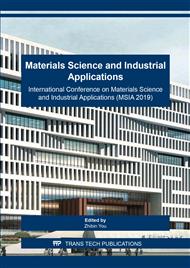[1]
F.S. Wang, Y.Y. Ji, X.S. Yu, H. Chen, Z.F. Yue, Ablation damage assessment of aircraft carbon fiber/epoxy composite and its protection structures suffered from lightning strike, Compos. Struct.145 (2016) 226-241.
DOI: 10.1016/j.compstruct.2016.03.005
Google Scholar
[2]
X.Q. Ma, Y.Z. Gu, M. Li, Y.X. Li, D.M. Zhang, L.J. Jia, Z.G. Zhang, Properties of carbon fiber composite laminates fabricated by coresin film infusion process for different prepreg materials, Polym. Compos. 34(2013) 2008-2018.
DOI: 10.1002/pc.22608
Google Scholar
[3]
S.J. Chen, Composite technology and large aircraft, Acta Aeronautica et Astronautica Sinica. 29(2008) 605-610.
Google Scholar
[4]
X. Wang, F. Xie, M. Li, Z. Zhang, Influence of tool assembly schemes and integral molding technologies on compaction of T-stiffened skins in autoclave process, J. Reinf. Plast. Comp. 29(2010) 1311-1322.
DOI: 10.1177/0731684409102765
Google Scholar
[5]
D. Walczyk, J. Kuppers, Thermal press curing of advanced thermoset composite laminate parts, Compos. Part A Appl.Sci. Manuf. 43(2012) 635-646.
DOI: 10.1016/j.compositesa.2011.12.008
Google Scholar
[6]
T.G. Gutowski, T. Morigaki, Z. Cai, S. Bauer, D. Boucher, J. Kingery, S. Wineman, The consolidation of laminate composites, J. Compos. Mater. 21(1987) 172-188.
DOI: 10.1177/002199838702100705
Google Scholar
[7]
R. Davé, A unified approach to modeling resin flow during composite processing, J. Compos. Mater. 24(1990) 22-41.
DOI: 10.1177/002199839002400102
Google Scholar
[8]
F.C. Campbell, Manufacturing Processes for Advanced Composites,[M]// Manufacturing Processes for Advanced Composites. (2003).
Google Scholar
[9]
Z.J. Liu, Y.F. Zhang , K.W. Hu, Y. Chao, The Preparation of The Cross Stiffened Skin by The Silicon Rubber Thermal Expansion Molding, Fiber Reinforced Plastics/composites, 31(2010):54-56.
Google Scholar
[10]
M. Shao , Y.Z. Gu, Y. Cheng, J. Sun, M. LI, Z.G. Zhang, Thermal Expansion Mold Design Using Silicone Rubber and Processing Quality Analysis of Bidirectional Stiffened Plates, Acta Aeronautica et Astronautica Sinica. 33(2012) 1116-1124.
Google Scholar
[11]
G.H. Kim, J.H. Choi, J.H Kweon, Manufacture and performance evaluation of the composite hat-stiffened panel, Compos. Struct. 92(2010) 2276-2284.
DOI: 10.1016/j.compstruct.2009.07.019
Google Scholar
[12]
G. Sala, Advances in elastomeric tooling technology, Materials & Design, 17(1996):33-42.
Google Scholar
[13]
F. Deng, L.H. Zhan, J. Zou, Research of Pressure Online Monitoring of Resin Matrix Composite Hat-stiffened Component during Curing Process, Fiber Reinforced Plastics/composites, (2018).
Google Scholar
[14]
J. Lin, X.F. Yao, Y.H. Liu, Z.Z. Cen, Z.J. Kou, X.C. Hu, D. Dai, Thermo-viscoelastic analysis of the integrated T-shaped composite structures, Compos. Sci. Technol. 70(2010) 1497-1503.
Google Scholar
[15]
J.D. Russell, M.S. Madhukar, M.S. Genidy, A.Y. Lee, A new method to reduce cure-induced stresses in thermoset polymer composites, part III: correlating stress history to viscosity, degree of cure, and cure shrinkage, J. Compos. Mater. 34(2000) 1926-1947.
DOI: 10.1106/uy9u-f2qw-2fkk-91kg
Google Scholar
[16]
A.S. Ganapathi, M. Maheshwari, S.C. Joshi, Z. Chen, A.K. Asundi, S.C. Tjin, In-situ measurement and numerical simulation of resin pressure during Glass/Epoxy prepreg composite manufacturing, Measurement, 94(2016): 505-514.
DOI: 10.1016/j.measurement.2016.08.028
Google Scholar


